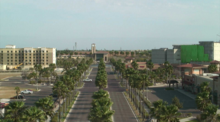McAllen, Texas
[7] In 1904, the Hidalgo and San Miguel Extension (now the Sam Fordyce Branch) of the St. Louis, Brownsville and Mexico Railway reached the Santa Anita Ranch.The new community, which was named for John McAllen, had the depot nearest the county seat, Hidalgo, 8 mi (13 km) to the south.By 1911, 5,000 acres (2,000 ha) were under cultivation in East McAllen: commodity crops of cotton, alfalfa, broom corn, citrus fruits, grapes, and figs were raised.In 1916, 20,000 New York state troops were stationed at McAllen to help quell border disturbances related to the Mexican Civil War.The town was a petroleum and farm chemurgic center with a population of 11,877 in 1940, by which time it had adopted the nickname "The City of Palms".Its construction resulted in increased tourist trade, making McAllen a winter resort and port of entry to Mexico.The discovery of oil in the Reynosa area in 1947 attracted a large migration of people from the Mexican interior to jobs in the region.The tourism industry continued to expand as people traveled to the area from both Mexico and the northern United States.In order to deal with overcrowded facilities in 2019 resulting from the arrival of Central American migrant caravans, immigration authorities were releasing a few hundred asylum seekers daily to private groups that assist them with basic needs and travel arrangements.[14] Portions of the razor wire coils considered unnecessary by the city were removed after troops had placed it at the border.[15] The Marine Corps Commandant General Robert Neller expressed concerns about the impact of continuing border support on combat readiness for the troops.The McAllen city limits extend to the southwest as far as the Rio Grande, directly north of Reynosa, Tamaulipas, in Mexico.The Anzalduas International Bridge crosses the Rio Grande at this point, 11 mi (18 km) southwest of downtown McAllen.According to the United States Census Bureau, the city has a total area of 48.6 square miles (126.0 km2), of which 0.3 sq mi (0.8 km2), or 0.62%, is covered by water.Many thorny shrubs and deciduous trees occur in the area, such as the Rio Grande ash (Fraxinus berlandieriana), cedar elm (Ulmus crassifolia), and honey mesquite (Prosopis glandulosa).In December 2017, McAllen received almost 3 in (76 mm) of snow, nearly 13 years after the previous snowfall, which took place during the 2004 Christmas Eve United States winter storm.In February 2021, McAllen reached record low temperatures between 10 °F (−12 °C) and 20 °F (−7 °C) and lost power, heat, and water for a week due to Winter Storm Uri.The article noted that while the area has a higher prevalence of obesity and diabetes, its rates of infant mortality, HIV, and tobacco use were lower than the national average.In the show, the overweight participant visits morbidly obese McAllen residents to find motivation for lifestyle and diet changes.Under U.S. and Mexican laws and NAFTA provisions, the FTZ designation offers specific cost-saving opportunities to manufacturers.Until 2014, McAllen was home to the Texas Thunder of the independent United League Baseball, who played at Edinburg Stadium.The Quinta Mazatlan, a historic Spanish colonial mansion, is used as McAllen's wing of the World Birding Center.This preserved green space offers visitors a chance to explore walking trails, climb a small hill, and has a cactus garden - all without any charge for admission.The United States Border Patrol Central Processing Center is located at 3700 W Ursula Avenue, McAllen, Texas.




McAllen (surname)McAllen Convention CenterMcAllen Public LibraryCountyHidalgoIncorporatedCouncil-ManagerCity CouncilJavier VillalobosCity ManagerTexas State RepresentativeRobert GuerraTexas State SenatorJuan HinojosaU.S. RepresentativeMonica De La CruzTime zoneUTC–6Central (CST)UTC–5ZIP codesArea codeSales TaxU.S. stateHidalgo CountyRio Grande ValleyMexico–United States borderRio GrandeMexicanReynosaGulf of Mexico2020 census23rd-most populousMcAllen–Edinburg–MissionReynosa–McAllen metropolitan areamaquiladoraNorth American Free Trade AssociationTimeline of McAllen, TexasSt. Louis, Brownsville and Mexico Railwaybroom cornborder disturbanceshome rulefarm chemurgic centersuspension bridgeTamaulipasMcAllen–Hidalgo–Reynosa International Bridgenatural gasforeign trade zoneMexican pesorecessionUnited States federal government shutdown of 2018–2019Mexico–United States barrierborder agentsKirstjen Nielsenovercrowded facilities in 2019Central American migrant caravansasylum seekersU.S military troops were mobilizedrazor wire coilsmilitary helicopterslaw enforcement dutiesMarine Corps CommandantRobert Nellerborder supportGranjenoMissionPalmhurstEdinburgcounty seatAnzalduas International BridgeSan AntonioCorpus ChristiLaredoBrownsvilleMonterreyUnited States Census BureautropicalshrubsdeciduousFraxinus berlandierianaUlmus crassifoliaProsopis glandulosaSouth Texassubtropical climateKöppen climate classificationsemiarid climatewet seasondry seasondew pointrelative humidityheat indexcontiguous United StatesSouth FloridaCoachellaImperialYuma Desertdew pointsAtlantic hurricane seasonDecember 25, 20042004 Christmas Eve United States winter stormWinter Storm UriHurricane Dolly (2008)Hurricane Hanna (2020)McAllen Miller International AirportprecipitationBlack or African AmericanNative AmericanAlaska NativePacific IslanderMixed race or multiracialHispanic or Latinocensus of 2020census of 2010racial makeupper capita incomepoverty lineHomicideRobberyAggravated assaultTotal violent crimeBurglaryLarceny-theftMotor vehicle theftTotal property crimeThe New YorkerAtul Gawande